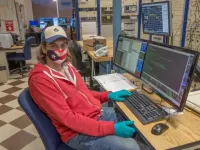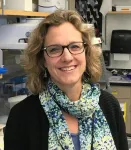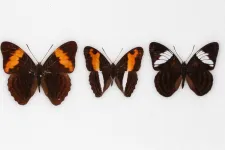With masks on, three feet is just as safe as six feet apart in Massachusetts schools
Statewide study showed no significant differences in COVID-19 case rates between K-12 districts that implemented 3-feet versus 6-feet of physical distancing
2021-03-11
(Press-News.org) BOSTON - As COVID-19 infection rates continue to fall, Massachusetts officials are signaling it's almost time to end remote learning and send all school-aged children back to the classroom. While emerging data suggest young children and schools have not been primary drivers of the COVID-19 pandemic, evidence to guide best practices to prevent the spread of the virus in the school setting has been limited and, as a result, national and international recommendations are inconsistent.
A study led by Beth Israel Deaconess Medical Center (BIDMC) physician-researchers provides new, much-needed data about the optimal physical distancing between students for the prevention of COVID-19 in the school setting. In a retrospective, statewide cohort study, the researchers compared the rates of COVID-19 cases in students and staff in Massachusetts public schools among districts with universal mask mandates but different physical distancing requirements. The team found no substantial difference in the number of cases of COVID-19 among either students or staff in school districts that implemented a distancing policy of three feet versus six feet between students. The findings, published in the journal Clinical Infectious Diseases, suggest that lower physical distancing policies can be adopted in school settings with masking mandates without negatively impacting student or staff safety.
"Prior studies have not directly compared the impact of different physical distancing policies among students attending in-person school," said lead author Polly van den Berg, MD, a fellow in the Division of Infectious Diseases at BIDMC. "This research, which found no substantial difference in the number of cases among either students or staff in school districts that implemented a distancing policy of three versus six feet between students, is important because many school buildings have physical infrastructure that cannot accommodate six feet of distancing and bring all (or most) students back into the classroom."
Van den Berg and colleagues looked at publicly available data from 251 Massachusetts school districts, encompassing 537,336 students and 99,390 staff who attended in-person instruction during a 16-week study period from September 2020 to January 2021. Using a combination of information - including individual district infection control plans, the number of infections reported to the Commonwealth by districts, and community rates of COVID-19 from a non-partisan, not-for-profit data dashboard - the scientists found no significant difference in the rate of COVID-19 cases among students and staff in districts that mandated six feet of distancing versus in districts that mandated three feet of distancing. The scientists note that physical distancing was only one of several infection prevention measures taken by school districts.
"These data can be used to inform and update how infection control plans are implemented in school settings," added corresponding author Westyn Branch-Elliman, MD, MMSc, an infectious disease specialist at BIDMC and a clinical investigator at VA Boston Healthcare System. "It is important to remember that distancing was just one of a number of interventions adopted in the districts included in our analysis. Across the districts included in our study, there was a near-universal masking mandate, thus our study addresses the question of the effectiveness of three versus six feet of distancing among students and staff who are wearing masks."
The team's findings also showed that, in general, schools had lower overall rates of infection than their surrounding communities, lending support to the idea that in-person learning is not a major driver of the pandemic; however, district case rates were tightly linked to those of the community, particularly among staff.
"Early in the pandemic, infection control plans for schools and other settings were developed based on the best available evidence at the time -- which, early on, was limited," said Branch-Elliman, also an Assistant Professor of Medicine at Harvard Medical School. "We hope that our findings can be used to update current recommendations about distancing policy, and ultimately, to help return more students to the classroom."
INFORMATION:
Co-authors include Elissa M. Schechter-Perkins, MD, MPH, of Boston University School of Medicine and Boston Medical Center; Rebecca S. Jack, MPP of COVID-19 School Response Dashboard; Isabella Epshtein, MPP, of VA Boston Center for Healthcare Organization and Implementation Research; Richard Nelson, PhD, Veterans Affairs Salt Lake City Healthcare System and University of Utah School of Medicine; and Emily Oster, PhD, of COVID-19 School Response Dashboard and Brown University Watson Institute for International and Public Affairs.
The authors received no financial support for the research, authorship, and/or publication of this article. WBE is the site PI for a grant funded by Gilead pharmaceuticals (funds to institution). EO and RJ are affiliated with the COVID-19 School Dashboard, which is funded in part by the Chan Zuckerberg Foundation and the Arnold Foundation. All other authors have no conflicts to report.
About Beth Israel Deaconess Medical Center
Beth Israel Deaconess Medical Center is a patient care, teaching and research affiliate of Harvard Medical School and consistently ranks as a national leader among independent hospitals in National Institutes of Health funding. BIDMC is the official hospital of the Boston Red Sox. For more information, visit http://www.bidmc.org.
Beth Israel Deaconess Medical Center is a part of Beth Israel Lahey Health, a health care system that brings together academic medical centers and teaching hospitals, community and specialty hospitals, more than 4,000 physicians and 35,000 employees in a shared mission to expand access to great care and advance the science and practice of medicine through groundbreaking research and education.
ELSE PRESS RELEASES FROM THIS DATE:
2021-03-11
Climate change is affecting the water balance of our planet: depending on the region and the time of year, this can influence the amount of water in rivers potentially resulting in more flooding or drought. River flow is an important indicator of water resources available to humans and the environment. The amount of available water also depends on further factors, such as direct interventions in the water cycle or land use change: if, for example, water is diverted for irrigation or regulated via reservoirs, or forests are cleared and monocultures grown in their place, this can have an impact on river flow.
However, how river flow ...
2021-03-11
Using the same principles that make polarized sunglasses possible, a team of researchers at the Arecibo Observatory in Puerto Rico have developed a technique that will help better defend against asteroids on a collision course with Earth.
A new study recently published in The Planetary Science Journal found a better way to interpret radar signals bounced off asteroids' surfaces. The data can better tell us if an asteroid is porous, fluffy or rocky, which matters because there are hundreds of near-Earth asteroids that could potentially hit the planet.
"Learning more about the physical properties of asteroids is crucial in Planetary Defense," says Dylan Hickson the lead author and a research scientist at the Arecibo Observatory in Puerto Rico. "A porous, fluffy asteroid does ...
2021-03-11
The planet GJ 1132 b appears to have begun life as a gaseous world with a thick blanket of atmosphere. Starting out at several times the radius of Earth, this so-called "sub-Neptune" quickly lost its primordial hydrogen and helium atmosphere, which was stripped away by the intense radiation from its hot, young star. In a short period of time, it was reduced to a bare core about the size of Earth.
To the surprise of astronomers, new observations from Hubble [1] have uncovered a secondary atmosphere that has replaced the planet's first atmosphere. It is rich in hydrogen, hydrogen cyanide, methane and ammonia, and also has a hydrocarbon haze. Astronomers theorise that hydrogen from the original atmosphere was absorbed into the planet's molten magma mantle and is now being slowly released ...
2021-03-11
Breast cancer is harmful enough on its own, but when cancer cells start to metastasize -- or spread into the body from their original location -- the disease becomes even more fatal and difficult to treat.
Thanks to new research published in Oncogene from the lab of University of Colorado Cancer Center associate director of basic research Heide Ford, PhD, in collaboration with Michael Lewis, PhD, from Baylor College of Medicine, doctors may soon have a better understanding of one mechanism by which metastasis happens, and of potential ways to slow it down.
"Metastasis is a huge problem nobody's tackled very well," says Ford, who ...
2021-03-11
The universe is filled with magnetic fields. Understanding how magnetic fields are generated and amplified in plasmas is essential to studying how large structures in the universe were formed and how energy is divided throughout the cosmos.
An international collaboration, co-led by researchers at the University of Rochester, the University of Oxford, and the University of Chicago, conducted experiments that captured for the first time in a laboratory setting the time history of the growth of magnetic fields by the turbulent dynamo, a physical mechanism thought to be responsible for generating ...
2021-03-11
Optical-resolution photoacoustic microscopy (OR-PAM), a new hybrid imaging technique, allows us to listen to the sound of light and see the color of biological tissue itself. It can be used for live, multicontrast functional imaging, but the limited wavelength choice of most commercial lasers and the limitations of the existing scanning methods have meant that OR-PAM can obtain only one or two different types of contrast in a single scan. These limitations have made multicontrast functional imaging time-consuming, and it's been difficult to capture the ...
2021-03-11
Ann Arbor, March 11, 2020 - Black and Hispanic people experience a higher risk for COVID-19 and severe illness, influenced by factors such as discrimination, housing, and healthcare access and utilization. Now, a END ...
2021-03-11
CHAMPAIGN, Ill. -- The chronic stress of living in neighborhoods with high rates of violence and poverty alters gene activity in immune cells, according to a new study of low-income single Black mothers on the South Side of Chicago.
The changes in stress-related gene expression reflect the body's "hunker down" response to long-term threat, a physiological strategy for lying low and considering new actions rather than launching an immediate "fight-or-flight" response. This has implications for health outcomes in communities of color and other marginalized populations, said researchers at the University of Illinois Urbana-Champaign and collaborators at the University of Kentucky and UCLA. The researchers published the study in the journal Psychoneuroendocrinology.
"The ...
2021-03-11
GAINESVILLE, Fla. --- The showy colors of some butterflies could advertise their speed and nimbleness, much like a coat of bright yellow paint on a sports car. A new study shows birds can learn to recognize these visual cues, avoiding not only butterflies they've failed to nab in the past but similar-looking species as well.
The research provides some of the strongest evidence to date for the idea of evasive mimicry, a strategy in which animals protect themselves from predators by matching the colors or patterns of agile relatives. First proposed more than 60 years ago, the hypothesis has been a challenge to test.
But in an experimental setting, ...
2021-03-11
SAN ANTONIO -- Surgically opening the windpipe, or trachea, within the first seven days of the start of mechanical ventilation decreases the time patients spend on ventilators, shortens their ICU stay and lowers their risk of ventilator-associated pneumonia, according to a systematic review published Thursday (March 11) in JAMA Otolaryngology-Head & Neck Surgery.
"We analyzed the existing medical literature to unravel a question that is very pertinent to adult critical care," said senior author Alvaro Moreira, MD, MSc, of The University of Texas Health Science Center at San Antonio (UT Health San ...
LAST 30 PRESS RELEASES:
[Press-News.org] With masks on, three feet is just as safe as six feet apart in Massachusetts schools
Statewide study showed no significant differences in COVID-19 case rates between K-12 districts that implemented 3-feet versus 6-feet of physical distancing




